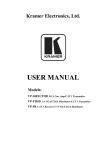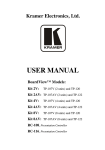Download Kramer Electronics TP-105HD
Transcript
Kramer Electronics, Ltd. Preliminary USER MANUAL Models: TP-104, TP-104HD, XGA Line Transmitter/DA TP-105, TP-105(HD), CAT 5 Line Driver/DA TP-121, XGA/Audio Line Transmitter TP-122, XGA/Audio Line Receiver TP-123, XGA/Audio/Data Line Transmitter TP-124, XGA/Audio/Data Line Receiver Contents Contents 1 2 2.1 3 3.1 3.2 3.3 4 5 6 6.1 Introduction Getting Started Quick Start Overview Shielded Twisted Pair (STP)/Unshielded Twisted Pair (UTP) About the Power Connect Feature Recommendations for Achieving the Best Performance Your TP-104/TP-104HD XGA Line Transmitter/DA Your TP-105/TP-105(HD) CAT 5 Line Driver/DA Your TP-121/TP-122 Your TP-121 XGA/Audio Line Transmitter 6.2 Your TP-122 XGA/Audio Line Receiver 10 7 7.1 Your TP-123/TP-124 Your TP-123 XGA/Audio/Data Line Transmitter 13 13 7.2 Your TP-124 XGA/Audio/Data Line Receiver 15 Connecting the XGA/Audio Line Transmitter/Receiver Wiring the CAT 5 LINE IN/LINE OUT RJ-45 Connectors Connecting the XGA/Audio/Data Line Transmitter/Receiver Controlling via RS-232 (for example, using a PC) Configuring a 1:4 XGA to TP Transmitter/Receiver/DA Configuring a TP-105 CAT 5 Line Driver/DA Technical Specifications 17 19 19 22 23 25 27 6.1.1 6.2.1 6.2.2 7.1.1 7.2.1 8 8.1 9 9.1 10 11 12 The TP-121 Internal Polarity Switches Your TP-122 XGA/Audio Line Receiver (Topside) Your TP-122 XGA/Audio Line Receiver (Underside) The TP-123 Internal Polarity Switches Your TP-124 XGA/Audio/Data Line Receiver (Underside) 1 1 2 4 4 5 5 6 8 9 9 10 10 12 14 16 Figures Figure 1: TP-104 XGA Line Transmitter/DA Figure 2: TP-104HD XGA Line Transmitter/DA Figure 3: TP-104 (Underside Panel) Figure 4: TP-105 CAT 5 Line Driver/DA Figure 5: TP-121 XGA/Audio Line Transmitter Figure 6: TP-121 Internal Polarity Switches Figure 7: TP-122 XGA/Audio Line Receiver (Topside) Figure 8: TP-122 XGA/Audio Line Receiver (Underside) Figure 9: TP-123 XGA/Audio/Data Line Transmitter 6 6 7 8 9 10 11 12 13 i Contents Figure 10: TP-123 Internal Polarity Switches Figure 11: TP-124 XGA/Audio/Data Line Receiver (Topside) Figure 12: TP-124 XGA/Audio/Data Line Receiver (Underside) Figure 13: Connecting the XGA/Audio Line Transmitter/Receiver System Figure 14: CAT 5 PINOUT Figure 15: Connecting the XGA/Audio/Data Line Transmitter/Receiver System Figure 16: RS-232 PINOUT Connection Figure 17: Configuring a 1:4 XGA to Twisted Pair Transmitter/Receiver/DA Figure 18: Configuring a TP-105 CAT 5 Line Driver/DA 14 15 16 18 19 21 22 24 26 Tables Table 1: TP-104, TP-104HD XGA Line Transmitter/DA Features Table 2: TP-104 (Underside Panel) Features Table 3: TP-105 CAT 5 Line Driver/DA Features Table 4: TP-121 XGA/Audio Line Transmitter Features Table 5: Features of the TP-121 Internal Polarity Switches Table 6: TP-122 XGA/Audio Line Receiver (Topside) Features Table 7: TP-122 XGA/Audio Line Receiver (Underside) Features Table 8: TP-123 XGA/Audio/Data Line Transmitter Features Table 9: Features of the TP-123 Internal Polarity Switches Table 10: TP-124 XGA/Audio/Data Line Receiver (Topside) Features Table 11: TP-124 XGA/Audio/Data Line Receiver (Underside) Features Table 12: CAT 5 PINOUT Table 13: RS-232 PINOUT Connection Table 14: Technical Specifications of the TP-104 and the TP-104HD Table 15: Technical Specifications of the TP-105 and the TP-105(HD) Table 16: Technical Specifications of the TP-121/TP-122/TP-123/TP-124 ii 7 7 8 9 10 11 12 14 14 16 16 19 22 27 27 28 KRAMER: SIMPLE CREATIVE TECHNOLOGY Introduction 1 Introduction Welcome to Kramer Electronics! Since 1981, Kramer Electronics has been providing a world of unique, creative, and affordable solutions to the vast range of problems that confront the video, audio, presentation, and broadcasting professional on a daily basis. In recent years, we have redesigned and upgraded most of our line, making the best even better! Our 1,000-plus different models now appear in 11 groups 1 that are clearly defined by function. Thank you for purchasing your Kramer TOOLS: TP-104, TP-104HD XGA Line Transmitter/DA, and/or TP-105, TP-105(HD), CAT 5 Line Driver/DA, and/or TP-121 XGA/Audio Line Transmitter, and/or TP-122 XGA/Audio Line Receiver, and/or TP-123, XGA/Audio/Data Line Transmitter, and/or TP-124, XGA/Audio/Data Line Receiver, which are ideal for: • Presentation and multimedia applications • Long range graphics distribution for schools, hospitals, security, and stores The package includes one or more of the following Kramer TOOLS: • TP-104/TP-104HD, TP-105/TP-105(HD), TP-121, TP-122, TP-123, or TP-124 • Power adapter (12V DC) • This user manual 2 2 Getting Started We recommend that you: • Unpack the equipment carefully and save the original box and packaging materials for possible future shipment • Review the contents of this user manual • Use Kramer high-performance high-resolution cables 3 1 GROUP 1: Distribution Amplifiers; GROUP 2: Switchers and Matrix Switchers; GROUP 3: Control Systems; GROUP 4: Format/Standards Converters; GROUP 5: Range Extenders and Repeaters; GROUP 6: Specialty AV Products; GROUP 7: Scan Converters and Scalers; GROUP 8: Cables and Connectors; GROUP 9: Room Connectivity; GROUP 10: Accessories and Rack Adapters; GROUP 11: Sierra Products 2 Download up-to-date Kramer user manuals at http://www.kramerelectronics.com 3 The complete list of Kramer cables is on our Web site at http://www.kramerelectronics.com 1 Getting Started 2.1 Quick Start This quick start chart summarizes the basic setup and operation steps. 2 KRAMER: SIMPLE CREATIVE TECHNOLOGY Getting Started 3 Overview 3 Overview This user manual describes the following Kramer TOOLS: • TP-104/TP-104HD XGA Line Transmitter/DA is a line transmitter/1:4 DA that receives an XGA signal and transmits it over four CAT 5 cables to appropriate receivers (see section 4) • TP-105/TP-105(HD) CAT 5 Line Driver/DA receives a CAT 5 input 1 and distributes it to two identical outputs (see section 5) • TP-121 XGA/Audio Line Transmitter and the TP-122 XGA/Audio Line Receiver (see section 6) • TP-123 XGA/Audio/Data Line Transmitter and the TP-124 XGA/Audio/Data Line Receiver (see section 7) This section describes: • Using shielded twisted pair (STP)/unshielded twisted pair (UTP), see section 3.1 • The power connect feature, see section 3.2 • Recommendations for achieving the best performance, see section 3.3 3.1 Shielded Twisted Pair (STP)/Unshielded Twisted Pair (UTP) We recommend that you use Shielded Twisted Pair (STP) cable. There are different levels of STP cable available, and we advise you to use the best quality STP cable that you can afford. Our non-skew-free cable, Kramer BC-STP is intended for analog signals where skewing is not an issue. For cases where there is skewing, our UTP skew-free cable, Kramer BC-XTP, may be used. Bear in mind, though, that we advise using STP cables where possible, since the compliance to electromagnetic interference was tested using those cables. Although Unshielded Twisted Pair (UTP) cable might be preferred for long range applications, the UTP cable should be installed far away from electric cables, motors and so on, which are prone to create electrical interference. However, since the use of UTP cable might cause inconformity to electromagnetic standards, Kramer does not commit to meeting the standard with UTP cable. 1 Video only 4 KRAMER: SIMPLE CREATIVE TECHNOLOGY Overview 3.2 About the Power Connect Feature The Power Connect feature applies as long as the cable can carry power. This feature is available when using STP cable and the distance does not exceed 50m on standard CAT 5 cable. For longer distances, heavy gauge cable should be used 1. For units which are connected via RJ-45 connectors, make sure that the shield of the STP cable is connected to the metal casing of the connectors on both ends of the cable. For units which are connected via terminal block connectors, the shield of the STP cable must be connected to a ground terminal on the units at both ends (use the ground terminal of the power supply connection if necessary). For a CAT 5 cable exceeding a distance of 50m, separate power supplies should be connected to the transmitter and to the receiver simultaneously. 3.3 Recommendations for Achieving the Best Performance To achieve the best performance: • Use only good quality connection cables 2 to avoid interference, deterioration in signal quality due to poor matching, and elevated noise levels (often associated with low quality cables). • Avoid interference from neighboring electrical appliances that may adversely influence signal quality and position your Kramer product away from moisture, excessive sunlight and dust 1 CAT 5 cable is still suitable for the video/audio transmission, but not for feeding the power at these distances 2 Available from Kramer Electronics on our Web site at http://www.kramerelectronics.com 5 Your TP-104/TP-104HD XGA Line Transmitter/DA 4 Your TP-104/TP-104HD XGA Line Transmitter/DA The TP-104/TP-104HD 1 is a line transmitter/1:4 DA that receives an XGA signal 2 and transmits it over four CAT 5 cables to appropriate receivers. In particular, the TP-104/TP-104HD: • Has a transmission range of more than 300ft (more than 100m) • Can power or be powered by the receiver over the same CAT 5 cable and is 12V DC fed Figure 1 defines the TP-104 and Figure 2 defines the TP-104HD: Figure 1: TP-104 XGA Line Transmitter/DA Figure 2: TP-104HD XGA Line Transmitter/DA 1 The TP-104HD is similar to the TP-104 but can also receive HD signals (high definition resolutions: 480p, 576p, 720p, 1080i and 1080p) 2 The terminology XGA is used throughout this manual, where this implies any RGBHV signal on a 15-pin HD (F) connector having a resolution from VGA up to XGA 6 KRAMER: SIMPLE CREATIVE TECHNOLOGY Your TP-104/TP-104HD XGA Line Transmitter/DA Table 1: TP-104, TP-104HD XGA Line Transmitter/DA Features 1 # 12V DC Feature Function 2 OUT 4 RJ-45 connector 3 OUT 3 RJ-45 connector 4 OUT 2 RJ-45 connector 5 OUT 1 RJ-45 connector 6 INPUT 15-pin HD (F) connector +12V DC connector for powering the unit Connects to 1 the LINE IN RJ-45 connector on the TP-122 XGA/Audio Line Receiver or the TP-120 XGA Line Receiver 2 Connects to1 the LINE IN RJ-45 connector on the TP-122 XGA/Audio Line Receiver or the TP-120 XGA Line Receiver 2 Connects to1 the LINE IN RJ-45 connector on the TP-122 XGA/Audio Line Receiver or the TP-120 XGA Line Receiver 2 Connects to1 the LINE IN RJ-45 connector on the TP-122 XGA/Audio Line Receiver or the TP-120 XGA Line Receiver 2 Connect to the XGA source 7 ON LED Illuminates when receiving power Figure 3 and Table 2 define the TP-104 and TP-104HD underside panel: Figure 3: TP-104 (Underside Panel) Table 2: TP-104 (Underside Panel) Features 1 2 # Feature VS Switch HS Switch Function Slide the switch up (to NORMAL) to retain the polarity 3 Slide the switch down to change the VS polarity to NEGATIVE polarity 4 Slide the switch up (to NORMAL) to retain the polarity Slide the switch down3 to change the HS polarity to NEGATIVE polarity4 1 Using a UTP CAT 5 cable with RJ-45 connectors at both ends (the PINOUT is defined in Table 12 and Figure 14) 2 Refer to the separate user manual: PT-110, WP-110, PT-120, TP-120, which can be downloaded at http://www.kramerelectronics.com. Also, see the example illustrated in Figure 17 3 By default, both switches are set to NORMAL 4 Downward syncs 7 Your TP-105/TP-105(HD) CAT 5 Line Driver/DA 5 Your TP-105/TP-105(HD) CAT 5 Line Driver/DA The TP-105 1 receives a CAT 5 input, and distributes it to two identical outputs. In particular, the TP-105: • Has a transmission range of more than 300ft (more than 100m) over UTP cabling • Includes EQ. and level controls and is 12V DC fed Figure 4 and Table 3 define the TP-105: Figure 4: TP-105 CAT 5 Line Driver/DA Table 3: TP-105 CAT 5 Line Driver/DA Features 1 2 # Feature 12V DC OUT 2 RJ-45 connector 3 OUT 1 RJ-45 connector 4 INPUT RJ-45 connector 5 6 7 EQ. trimmer LEVEL trimmer ON LED Function +12V DC connector for powering the unit 2 Connects to the LINE IN RJ-45 connector on the TP-120 XGA Line Receiver 2 Connects to the LINE IN RJ-45 connector on the TP-120 XGA Line Receiver 2 Connects to the LINE OUT RJ-45 connector on the PT-110 XGA Line Transmitter Adjusts the video EQ. (equalization) compensation Adjusts 3 the video signal level Illuminates when receiving power 1 The TP-105HD (identified by a sticker on its underside) is identical in appearance to the TP-105. However, the TP-105HD can also receive HD signals (high definition resolutions: 480p, 576p, 720p, 1080i and 1080p), for example, from a TP-112HD XGA/HD Line Transmitter-DA, and not only computer graphics signals (for example, from a PT-110 as Figure 18 illustrates) 2 Using a UTP CAT 5 cable with RJ-45 connectors at both ends (the PINOUT is defined in Table 12 and Figure 14) 3 Insert a screwdriver into the hole and carefully rotate it, to trim the level 8 KRAMER: SIMPLE CREATIVE TECHNOLOGY Your TP-121/TP-122 6 Your TP-121/TP-122 This section defines the TP-121 XGA/Audio Line Transmitter (see section 6.1), and the TP-122 XGA/Audio Line Receiver (see section 6.2). 6.1 Your TP-121 XGA/Audio Line Transmitter The TP-121 is an XGA/audio stereo line transmitter that receives an XGA signal and an unbalanced stereo analog audio signal and transmits them over CAT 5 cable to a TP-122 receiver, converting the unbalanced stereo analog audio signal to digital audio (S/PDIF) stream before transmitting, thus preserving the quality of the audio signal. In particular, the TP-121: • Has a transmission range of more than 300ft (more than 100m), and a 20kHz audio bandwidth with an S/N ratio that exceeds 80dB on the same transmission range • Can power or be powered by the receiver over the same CAT 5 cable • Is 12V DC fed Figure 5 and Table 4 define the TP-121: Figure 5: TP-121 XGA/Audio Line Transmitter Table 4: TP-121 XGA/Audio Line Transmitter Features 1 2 3 4 5 # Feature 12V DC AUDIO IN 3.5mm mini jack LINE OUT RJ-45 connector XGA IN 15-pin HD (F) connector ON LED Function +12V DC connector for powering the unit Connects to the audio source Connects to 1 the LINE IN RJ-45 connector on the TP-122 XGA/Audio Line Receiver Connect to the XGA source Illuminates when receiving power 1 Using a UTP CAT 5 cable with RJ-45 connectors at both ends (the PINOUT is defined in Table 12 and Figure 14) 9 Your TP-121/TP-122 6.1.1 The TP-121 Internal Polarity Switches Figure 6 and Table 5 define the internal sync polarity switches inside the TP-121. Note, that you need to open the TP-121 unit to gain access to the Vs and Hs Polarity switches. After setting the switches, close the TP-121 unit. NORM. NEG. Figure 6: TP-121 Internal Polarity Switches Table 5: Features of the TP-121 Internal Polarity Switches Feature VS Switch HS Switch 6.2 Function 2 Slide the switch down , to set the V SYNC to negative polarity (NEG.); slide the switch up, to set the V SYNC to its input polarity (NORM.) Slide the switch down 1, to set the H SYNC to negative polarity (NEG.); slide the switch up, to set the H SYNC to its input polarity (NORM.) Your TP-122 XGA/Audio Line Receiver This section describes the topside (see section 6.2.1), and the underside 2 (see section 6.2.2) of the TP-122 XGA/Audio Line Receiver. 6.2.1 Your TP-122 XGA/Audio Line Receiver (Topside) The TP-122 is an XGA/audio line receiver that receives the coded CAT 5 signal transmitted by a TP-121, decodes it and converts it to XGA, stereo analog and S/PDIF digital audio outputs. The TP-122, with a TP-121, allows an operation range of more than 300ft (more than 100m) over standard CAT 5 cable. 1 By default, both switches are set down (for a negative V SYNC and H SYNC polarity) 2 The underside is identical on the TP-122 and TP-124 10 KRAMER: SIMPLE CREATIVE TECHNOLOGY Your TP-121/TP-122 In addition, the TP-122: • Can power or be powered by the transmitter over the same CAT 5 cable • Can change the polarity of decoding H and V Sync for video • Includes EQ. and level controls • Is 12V DC fed Figure 7 and Table 6 define the TP-122 XGA/Audio Line Receiver topside: Figure 7: TP-122 XGA/Audio Line Receiver (Topside) Table 6: TP-122 XGA/Audio Line Receiver (Topside) Features 1 2 3 4 5 6 7 8 9 # 12V DC Feature S/PDIF RCA connector ANALOG 3.5mm mini jack LINE IN RJ-45 connector XGA OUT 15-pin HD (F) connector LINK LED LEVEL trimmer EQ. 3 trimmer ON LED AUDIO OUT Function +12V DC connector for powering the unit Connects to the digital audio acceptor Connects to the analog audio acceptor 1 2 Connects to the TP-121 or the TP-104 Connects to the XGA acceptor Illuminates when receiving the correct input signal Adjusts4 the output signal level Adjusts 4 the cable compensation equalization level Illuminates when receiving power 1 Using a UTP CAT 5 cable with RJ-45 connectors at both ends (the PINOUT is defined in Table 12 and Figure 14) 2 The TP-104 does not accept the audio signals 3 Degradation and VGA/XGA signal loss can result from using long cables (due to stray capacitance), sometimes leading to a total loss of sharpness in high-resolution signals 4 Use a screwdriver to carefully rotate the trimmer, adjusting the appropriate level 11 Your TP-121/TP-122 6.2.2 Your TP-122 XGA/Audio Line Receiver (Underside) Figure 8 and Table 7 define the underside 1 of the TP-122 XGA/Audio Line Receiver: Figure 8: TP-122 XGA/Audio Line Receiver (Underside1) Table 7: TP-122 XGA/Audio Line Receiver (Underside) Features 1 2 # Feature VS Switch HS Switch Function 2 Slide the switch up to set the V SYNC to positive polarity; slide the switch down to set the V SYNC to negative polarity Slide the switch up 2 to set the H SYNC to positive polarity; slide the switch down to set the H SYNC to negative polarity 1 The underside is identical on the TP-122 and TP-124 2 By default, both switches are set down (for a negative V SYNC and H SYNC polarity) 12 KRAMER: SIMPLE CREATIVE TECHNOLOGY Your TP-123/TP-124 7 Your TP-123/TP-124 This section describes the TP-123 XGA/Audio/Data Line Transmitter (see section 7.1), and the TP-124 XGA/Audio/Data Line Receiver (see section 7.2). 7.1 Your TP-123 XGA/Audio/Data Line Transmitter The TP-123 is a high-performance transmitter that accepts a computer graphics input signal, an unbalanced stereo analog audio signal, unidirectional (RxD) RS-232 control commands and 12V DC power, over CAT 5 cable, and transmits to a TP-124 receiver. The stereo analog audio signal is converted to the digital audio (S/PDIF) stream before transmitting, thus preserving the quality of the audio source signals. The TP-123/TP-124 pair has a transmission range of more than 300ft (more than 100m) over UTP cabling. In addition, the TP-123: • Can power or be powered by the TP-124 receiver over the same CAT 5 cable and is 12V DC fed Figure 9 and Table 8 define the TP-123: Figure 9: TP-123 XGA/Audio/Data Line Transmitter 13 Your TP-123/TP-124 Table 8: TP-123 XGA/Audio/Data Line Transmitter Features 1 2 3 4 # 5 6 Feature 12V DC AUDIO IN 3.5mm mini jack RS-232 terminal block connector LINE OUT RJ-45 connector XGA IN 15-pin HD (F) connector ON LED Function +12V DC connector for powering the unit Connects to the audio source Connects to the PC or the Remote Controller (see section 9.1) 1 Connects to the LINE IN RJ-45 connector on the TP-124 XGA/Audio Line Receiver Connect to the XGA source Illuminates when receiving power 7.1.1 The TP-123 Internal Polarity Switches Figure 10 and Table 9 define the internal sync polarity switches inside the TP-123. Note, that you need to open the TP-123 unit to gain access to the Vs and Hs Polarity switches. After setting the switches, close the TP-123 unit. NORM. NEG. Figure 10: TP-123 Internal Polarity Switches Table 9: Features of the TP-123 Internal Polarity Switches Feature VS Switch HS Switch Function Slide the switch down2 to set the V SYNC to negative polarity (NEG.); slide the switch up to set the V SYNC to its input polarity (NORM.) Slide the switch down 2 to set the H SYNC to negative polarity (NEG.); slide the switch up to set the H SYNC to its input polarity (NORM.) 1 Using a UTP CAT 5 cable with RJ-45 connectors at both ends (the PINOUT is defined in Table 12 and Figure 14) 2 By default, both switches are set down (for a negative V SYNC and H SYNC polarity) 14 KRAMER: SIMPLE CREATIVE TECHNOLOGY Your TP-123/TP-124 7.2 Your TP-124 XGA/Audio/Data Line Receiver The TP-124 is a high-performance receiver obtaining the computer graphics signal/audio/control data from the Kramer TP-123 via UTP cabling at its CAT 5 Line input. The TP-124 outputs a computer graphics signal, an unbalanced stereo analog audio signal, a converted digital audio (S/PDIF) signal and RS-232 control commands. The unidirectional (TxD) RS-232 interface makes it possible to control virtually any devices over a transmission range of more than 300ft (more than 100m) over UTP cabling. The TP-124 can power or be powered by the TP-123 transmitter over the same CAT 5 cable. In addition, the TP-124 features: • Level and EQ. control for the XGA signals • The capability to change the polarity of decoding H and V Sync • 24 bit 48kHz S/PDIF digital audio that supplies the highest quality audio • Is 12V DC fed This section describes the topside of the TP-124 XGA/Audio/Data Line Receiver. The underside 1 of the TP-124 is described in section 6.2.2. Figure 11 and Table 10 define the topside of the TP-124 XGA/Audio/Data Line Receiver: Figure 11: TP-124 XGA/Audio/Data Line Receiver (Topside) 1 The underside is identical on the TP-124 and TP-122 15 Your TP-123/TP-124 Table 10: TP-124 XGA/Audio/Data Line Receiver (Topside) Features # 12V DC AUDIO OUT 1 2 3 Feature S/PDIF RCA connector ANALOG 3.5mm mini jack 4 5 RS-232 Terminal Block connector LINE IN RJ-45 connector 6 7 8 9 10 XGA OUT 15-pin HD (F) connector LINK LED LEVEL trimmer 3 EQ. trimmer ON LED Function +12V DC connector for powering the unit Connects to the digital audio acceptor Connects to the analog audio acceptor Connects to the controlled unit 1 Connects to the LINE OUT RJ-45 connector on the TP-123 or the TP-104 2 Connect to the XGA acceptor Illuminates when receiving the correct input signal 4 Adjusts the output signal level 4 Adjusts the cable compensation equalization level Illuminates when receiving power 7.2.1 Your TP-124 XGA/Audio/Data Line Receiver (Underside) Figure 12 and Table 11 define the underside 5 of the TP-124 XGA/Audio /Data Line Receiver: Figure 12: TP-124 XGA/Audio/Data Line Receiver (Underside1) Table 11: TP-124 XGA/Audio/Data Line Receiver (Underside) Features 1 2 # Feature VS Switch HS Switch Function Slide the switch up2 to set the V SYNC to positive polarity; slide the switch down to set the V SYNC to negative polarity Slide the switch up 6 to set the H SYNC to positive polarity; slide the switch down to set the H SYNC to negative polarity 1 Using a UTP cable with CAT 5 connectors at both ends (the PINOUT is defined in Table 12 and Figure 14) 2 The TP-104 does not accept the audio signals 3 Degradation and VGA/XGA signal loss can result from using long cables (due to stray capacitance), sometimes leading to a total loss of sharpness in high-resolution signals 4 Use a screwdriver to carefully rotate the trimmer, adjusting the appropriate level 5 The underside is identical on the TP-122 and TP-124 6 By default, both switches are set down (for a negative V SYNC and H SYNC polarity) 16 KRAMER: SIMPLE CREATIVE TECHNOLOGY Connecting the XGA/Audio Line Transmitter/Receiver 8 Connecting the XGA/Audio Line Transmitter/Receiver You can use the TP-121 and TP-122 to configure an XGA/Audio Lineto-Twisted Pair Transmitter and Receiver system. To connect the TP-121 XGA/Audio Line Transmitter with the TP-122 XGA/Audio Line Receiver, as the example in Figure 13 illustrates, do the following: 1. On the TP-121, connect the XGA source (for example, a laptop’s graphics card) to the XGA INPUT 15-pin HD (F) connector and an audio source to the AUDIO IN 3.5mm mini jack, for example, using a Kramer C-GMA/GMA cable (VGA 15-pin HD (M) +Audio jack to VGA 15-pin HD (M) +Audio jack)1. Alternatively, you can connect an XGA source to the XGA INPUT 15-pin HD (F) connector, and a separate audio source to the AUDIO IN 3.5mm mini jack. 2. On the TP-122, connect the XGA OUT 15-pin HD (F) connector to the XGA acceptor (for example, a display), and connect the AUDIO OUT S/PDIF RCA connector to the digital audio acceptor (for example, an AV Receiver), and the ANALOG 3.5mm mini jack to the analog audio acceptor (for example, a stereo audio recorder). 3. Connect the LINE OUTPUT RJ-45 connector on the TP-121 to the LINE IN RJ-45 connector on the TP-122, via UTP cabling (with a range of more than 300ft (>100m)), see section 8.1. 4. Connect the 12V DC power adapter to the power socket and connect the adapter to the mains electricity on both2 the TP-121 and the TP-122. The signal from the XGA source is transmitted via CAT 5 cable, decoded and converted at the XGA OUT 15-pin HD (F) connector to the XGA acceptor. 5. On the TP-122: Adjust 3 the video output signal level and/or cable compensation equalization level, if required If necessary, set the H SYNC and V SYNC switches 4, on the underside 1 Not supplied. The complete list of Kramer cables is on our Web site at http://www.kramerelectronics.com 2 If you cannot connect the power to both the TP-121 and TP-122, you can just connect the power to the TP-122 3 Use a screwdriver to carefully rotate the trimmer, adjusting the appropriate level 4 By default, both switches are set down (for negative V SYNC and H SYNC polarity) 17 Connecting the XGA/Audio Line Transmitter/Receiver Figure 13: Connecting the XGA/Audio Line Transmitter/Receiver System 18 KRAMER: SIMPLE CREATIVE TECHNOLOGY Connecting the XGA/Audio/Data Line Transmitter/Receiver 8.1 Wiring the CAT 5 LINE IN/LINE OUT RJ-45 Connectors Table 12 and Figure 14 define the UTP CAT 5 PINOUT, using a straight pin to pin cable with RJ-45 connectors: Table 12: CAT 5 PINOUT EIA /TIA 568A 9 PIN EIA /TIA 568B Wire Color Green/White Green Orange/White Blue Blue/White Orange Brown/White Brown 1 2 3 4 5 6 7 8 Pair 1 4 and 5 Pair 1 Pair 2 3 and 6 Pair 2 1 and 2 Pair 3 1 and 2 Pair 3 3 and 6 Pair 4 7 and 8 Pair 4 7 and 8 1 2 3 4 5 6 7 8 Figure 14: CAT 5 PINOUT PIN Wire Color Orange/White Orange Green/White Blue Blue/White Green Brown/White Brown 4 and 5 Connecting the XGA/Audio/Data Line Transmitter/Receiver You can use the TP-123 XGA/Audio/Data Line Transmitter and the TP-124 XGA/Audio/Data Line Receiver to configure a twisted pair transmitter and receiver system, to transmit the video, audio and RS-232 control signals via CAT 5 UTP cable. To connect the TP-123 and the TP-124 to configure a twisted pair transmitter and receiver system, as the example in Figure 15 illustrates, do the following: 1. On the TP-123, connect: An XGA source (for example, a laptop’s graphics card) to the XGA IN 15-pin HD (F) connector and an audio source to the Audio IN 3.5mm mini jack, for example, using a Kramer C-GMA/GMA cable (VGA 15-pin HD (M) +Audio jack to VGA 15-pin HD (M) +Audio jack) 1 An RS-232 cable with a 9-pin D-sub connector at one end to the laptop, and a 2 PIN terminal block connector at the other end to 1 Not supplied. The full list of Kramer cables is on our Web site at http://www.kramerelectronics.com. Alternatively, you can connect an XGA source to the XGA IN 15-pin HD (F) connector, and a separate audio source to the AUDIO IN 3.5mm mini jack 19 Connecting the XGA/Audio/Data Line Transmitter/Receiver the TP-123 RS-232 port 1 2. On the TP-124, connect: The XGA OUT 15-pin HD (F) connector to a display The S/PDIF Audio OUT RCA connector to a digital AV Receiver (leave the ANALOG Audio OUT 3.5mm mini jack unconnected) An RS-232 cable with a 2 PIN terminal block connector at one end to the TP-124 RS-232 port1, and a 9-pin D-sub connector at the other end to the RS-232 port on an RS-232 controllable device (for example, a switcher) 3. Connect the Line OUT RJ-45 connector on the TP-123 to the LINE IN RJ-45 connector on the TP-124, via UTP cabling 2 (with a range of more than 300ft (>100m)). 4. Connect the 12V DC power adapter to the power socket and connect the adapter to the mains electricity on both3 the TP-123 and the TP-124. 5. On the TP-124: Adjust 4 the video output signal level and/or cable compensation equalization level, if required If necessary, set the H SYNC and V SYNC switches 5, on the underside 1 As defined in Figure 16 and Table 13 2 For details of how to wire a CAT 5 LINE IN/LINE OUT RJ-45 connector, see section 8.1 3 If you cannot connect the power to both the TP-123 and TP-124, you can just connect the power to any one unit 4 Use a screwdriver to carefully rotate the trimmer, adjusting the appropriate level 5 By default, both switches are set down (for negative V SYNC and H SYNC polarity) 20 KRAMER: SIMPLE CREATIVE TECHNOLOGY Connecting the XGA/Audio/Data Line Transmitter/Receiver Figure 15: Connecting the XGA/Audio/Data Line Transmitter/Receiver System 21 Connecting the XGA/Audio/Data Line Transmitter/Receiver 9.1 Controlling via RS-232 (for example, using a PC) Prepare an RS-232 cable with a 9-pin D-sub connector at one end, and a 2 PIN terminal block connector at the other end, as defined in Figure 16 and Table 13: Figure 16: RS-232 PINOUT Connection Table 13: RS-232 PINOUT Connection Connect this PIN on the Terminal Block Connector: TxD RxD GND 22 To this PIN on the 9-pin D-sub Connector PIN 2 PIN 3 PIN 5 KRAMER: SIMPLE CREATIVE TECHNOLOGY Configuring a 1:4 XGA to TP Transmitter/Receiver/DA 10 Configuring a 1:4 XGA to TP Transmitter/Receiver/DA You can use the TP-104 XGA Line Transmitter/DA with the TP-120 XGA Line Receiver 1 to configure a 1:4 XGA-to-Twisted Pair DA system. To connect the TP-104 to four TP-120 units, as the example in Figure 17 illustrates, do the following: 1. On the TP-104, connect the XGA source (for example, a computer graphics source) to the XGA INPUT 15-pin HD (F) connector, and connect the line output RJ-45 connector 2: OUT 1 to the LINE IN RJ-45 connector on the TP-120 Unit I OUT 2 to the LINE IN RJ-45 connector on the TP-120 Unit II OUT 3 to the LINE IN RJ-45 connector on the TP-120 Unit III OUT 4 to the LINE IN RJ-45 connector on the TP-120 Unit IV 2. On the four TP-120 units, connect the: XGA OUT 15-pin HD (F) connector of Unit I to the XGA acceptor (for example, Display 1) XGA OUT 15-pin HD (F) connector of Unit II to the XGA acceptor (for example, Display 2) XGA OUT 15-pin HD (F) connector of Unit III to the XGA acceptor (for example, Display 3) XGA OUT 15-pin HD (F) connector of Unit IV to the XGA acceptor (for example, Display 4) 3. On each of the five Kramer TOOLS, connect the 12V DC power adapter to the power socket and connect the adapter to the mains electricity. The signal from the XGA source is transmitted via the four CAT 5 cables, decoded and converted at the each of the XGA OUT 15-pin HD (F) connectors to the XGA acceptors. 4. On each of the five Kramer TOOLS: Adjust 3 the video output signal level and/or cable compensation equalization level, if required If necessary, on the TP-120 units, set the H SYNC and V SYNC switches 4, on the underside 1 Refer to the separate user manual: PT-110, WP-110, PT-120, TP-120, which can be downloaded at http://www.kramerelectronics.com 2 Via UTP cabling (with a range of more than 300ft (>100m)). For details of how to wire a CAT 5 LINE IN/LINE OUT RJ-45 connector, see section 8.1 3 Use a screwdriver to carefully rotate the trimmer, adjusting the appropriate level 4 By default, both switches are set down (for negative V SYNC and H SYNC polarity) 23 Configuring a 1:4 XGA to TP Transmitter/Receiver/DA Figure 17: Configuring a 1:4 XGA to Twisted Pair Transmitter/Receiver/DA 24 KRAMER: SIMPLE CREATIVE TECHNOLOGY Configuring a TP-105 CAT 5 Line Driver/DA 11 Configuring a TP-105 CAT 5 Line Driver/DA You can connect the TP-105 CAT 5 Line Driver/DA—using a PT-110 XGA Line Transmitter and two TP-120 XGA Line Receiver 1 units—to transmit a computer graphics signal to two displays via long line CAT 5 UTP cabling. To connect the TP-105, as the example in Figure 17 illustrates, do the following: 1. On the PT-110, connect the: Computer graphics source to the XGA INPUT 15-pin HD (F) connector LINE OUTPUT RJ-45 connector 2 to the INPUT RJ-45 connector on the TP-105 2. On the TP-105, connect the: OUT 1 RJ-45 connector to the LINE IN RJ-45 on the first TP-120 OUT 2 RJ-45 connector to the LINE IN RJ-45 on the second TP-120 3. On the two TP-120 units, connect the: XGA OUT 15-pin HD (F) connector on the first TP-120 unit to the XGA acceptor (for example, Display 1) XGA OUT 15-pin HD (F) connector on the second TP-120 unit to the XGA acceptor (for example, Display 2) 4. On each of the four Kramer units, connect the 12V DC power adapter to the power socket and connect the adapter to the mains electricity. The signal from the XGA source is transmitted via the two CAT 5 cables, decoded and converted at the each of the XGA OUT 15-pin HD (F) connectors to the XGA acceptors. 5. If necessary: Adjust 3 the video output signal level and/or cable compensation equalization level on the TP-105 and on both the TP-120 units Set the H SYNC and V SYNC switches 4 on the underside of the TP-120 units 1 Refer to the separate user manual: PT-110, WP-110, TP-120, which can be downloaded from the Internet at http://www.kramerelectronics.com 2 Via UTP cabling (with a range of more than 300ft (>100m)). For details of how to wire a CAT 5 LINE IN/LINE OUT RJ-45 connector, see section 8.1 3 Use a screwdriver to carefully rotate the trimmer, adjusting the appropriate level 4 By default, both switches are set down (for negative V SYNC and H SYNC polarity) 25 Configuring a TP-105 CAT 5 Line Driver/DA Figure 18: Configuring a TP-105 CAT 5 Line Driver/DA 26 KRAMER: SIMPLE CREATIVE TECHNOLOGY Technical Specifications 12 Technical Specifications Table 14 includes the technical specifications of the TP-104, Table 15 includes the technical specifications of the TP-105, and Table 16 includes the technical specifications of the TP-121, TP-122, TP-123, and TP-124: 1 Table 14: Technical Specifications of the TP-104 2 and the TP-104HD INPUTS: OUTPUTS: MAX. OUTPUT LEVEL: BANDWIDTH (-3dB) 3: DIFF. GAIN3: DIFF. PHASE3: 3 K-FACTOR : 3 S/N RATIO : CONTROLS3: 3 COUPLING : POWER SOURCE: DIMENSIONS: WEIGHT: ACCESSORIES: TP-104 1 VGA/UXGA on a 15-pin HD connector 4 RJ-45 OUT connectors 1.4Vpp >150MHz, up to 1080p 4 3.2% 0.5Deg <0.05% 80dB EQ.: 0 to 33dB; LEVEL: –7.5dB to 4.4dB AC 12V DC 180mA 12.1cm x 7.18cm x 2.42cm (4.76" x 2.83" x 0.95") W, D, H 0.3kg (0.67lbs) approx. Power supply Table 15: Technical Specifications of the TP-1052 and the TP-105(HD) INPUTS: OUTPUTS: MAX. OUTPUT LEVEL: BANDWIDTH (-3dB) 5: DIFF. GAIN5: DIFF. PHASE5: K-FACTOR5: S/N RATIO5: CONTROLS5: COUPLING5: POWER SOURCE: DIMENSIONS: WEIGHT: ACCESSORIES: TP-105 1 RJ-45 OUT connector 2 RJ-45 OUT connectors 1.6Vpp Appropriate for VGA-UXGA, up to 1080p4 3.7% 0.5Deg <0.05% 69dB EQ.: 0 to 4.4dB @ 50MHz; LEVEL: –5.5dB to 1.4dB AC 12V DC 220mA 12.1cm x 7.18cm x 2.42cm (4.76" x 2.83" x 0.95") W, D, H 0.3kg (0.67lbs) approx. Power supply 1 Specifications are subject to change without notice 2 With 60m CAT 5 cable 3 For the TP-104 Transmitter/ TP-120 Receiver SETUP 4 The HD resolutions apply to the HD version of the machine 5 For the PT-110 to TP-105 to TP-120 Receiver SETUP 27 Technical Specifications Table 16: Technical Specifications of the TP-121/TP-122/TP-123/TP-124 INPUTS: OUTPUTS: TP-121 VIDEO: 1 VGA/UXGA on a 15-pin HD connector AUDIO: 1 audio ANALOG 3.5mm mini jack 1 RJ-45 OUT connector MAX. OUTPUT LEVEL: CONTROLS: BANDWIDTH (-3dB) 1: S/N RATIO: TOTAL GAIN: COUPLING: TND+N: POWER SOURCE: DIMENSIONS: WEIGHT: ACCESSORIES: OPTIONS: TP-122 1 RJ-45 LINE IN connector TP-123 VIDEO: 1 VGA/UXGA on a 15-pin HD connector AUDIO: 1 audio ANALOG 3.5mm mini jack 1 RJ-45 OUT connector VIDEO: 1 VGA/UXGA on a 15-pin HD connector AUDIO: 1 audio S/PDIF RCA connector 1 audio ANALOG 3.5mm mini jack VIDEO: 1V AUDIO: 2.5V RS-232 2 PIN Level: –7.5dB to Terminal Block +4.4dB, EQ.: 0dB to +33dBm (130m) @ 50MHz TP-124 1 RJ-45 LINE IN connector VIDEO: 1 VGA/UXGA on a 15pin HD connector AUDIO: 1 audio S/PDIF RCA connector 1 audio ANALOG 3.5mm mini jack VIDEO: 1V AUDIO: 2.5V RS-232 2 PIN Terminal Block Level: –7.5dB to +4.4dB, EQ.: 0dB to +33dBm (130m) @ 50MHz AUDIO: 20Hz – [email protected] VIDEO: 58dB unweighted, 68.3dB @5MHz weighted AUDIO: <–80dB AUDIO: Analog/analog: 0dB; Analog/SPDIF: –12dBFS AC AUDIO: <0.01% 12V DC 130mA (TP-123) 12V DC 130mA (TP-121) 12V DC 200mA (TP-124) 12V DC 190mA (TP-122) 12V DC 550mA (TP-123/TP-124 pair 12V DC 540mA (TP-121/TP-122 pair when powered from TP-123 via Power when powered from TP-121 via Power Connect) Connect) 12V DC 390mA (TP-123/TP-124 pair 12V DC 390mA (TP-121/TP-122 pair when powered from TP-124 via Power when powered from TP-122 via Power Connect) Connect) 12.1cm x 7.18cm x 2.42cm (4.76" x 2.83" x 0.95") W, D, H 0.3kg (0.67lbs) approx. Power supply 19” rack mount 1 For the Transmitter/Receiver pair 28 KRAMER: SIMPLE CREATIVE TECHNOLOGY LIMITED WARRANTY Kramer Electronics (hereafter Kramer) warrants this product free from defects in material and workmanship under the following terms. HOW LONG IS THE WARRANTY Labor and parts are warranted for seven years from the date of the first customer purchase. WHO IS PROTECTED? Only the first purchase customer may enforce this warranty. WHAT IS COVERED AND WHAT IS NOT COVERED Except as below, this warranty covers all defects in material or workmanship in this product. The following are not covered by the warranty: 1. Any product which is not distributed by Kramer, or which is not purchased from an authorized Kramer dealer. If you are uncertain as to whether a dealer is authorized, please contact Kramer at one of the agents listed in the Web site www.kramerelectronics.com. 2. Any product, on which the serial number has been defaced, modified or removed, or on which the WARRANTY VOID IF TAMPERED sticker has been torn, reattached, removed or otherwise interfered with. 3. Damage, deterioration or malfunction resulting from: i) Accident, misuse, abuse, neglect, fire, water, lightning or other acts of nature ii) Product modification, or failure to follow instructions supplied with the product iii) Repair or attempted repair by anyone not authorized by Kramer iv) Any shipment of the product (claims must be presented to the carrier) v) Removal or installation of the product vi) Any other cause, which does not relate to a product defect vii) Cartons, equipment enclosures, cables or accessories used in conjunction with the product WHAT WE WILL PAY FOR AND WHAT WE WILL NOT PAY FOR We will pay labor and material expenses for covered items. We will not pay for the following: 1. Removal or installations charges. 2. Costs of initial technical adjustments (set-up), including adjustment of user controls or programming. These costs are the responsibility of the Kramer dealer from whom the product was purchased. 3. Shipping charges. HOW YOU CAN GET WARRANTY SERVICE 1. To obtain service on you product, you must take or ship it prepaid to any authorized Kramer service center. 2. Whenever warranty service is required, the original dated invoice (or a copy) must be presented as proof of warranty coverage, and should be included in any shipment of the product. Please also include in any mailing a contact name, company, address, and a description of the problem(s). 3. For the name of the nearest Kramer authorized service center, consult your authorized dealer. LIMITATION OF IMPLIED WARRANTIES All implied warranties, including warranties of merchantability and fitness for a particular purpose, are limited in duration to the length of this warranty. EXCLUSION OF DAMAGES The liability of Kramer for any effective products is limited to the repair or replacement of the product at our option. Kramer shall not be liable for: 1. Damage to other property caused by defects in this product, damages based upon inconvenience, loss of use of the product, loss of time, commercial loss; or: 2. Any other damages, whether incidental, consequential or otherwise. Some countries may not allow limitations on how long an implied warranty lasts and/or do not allow the exclusion or limitation of incidental or consequential damages, so the above limitations and exclusions may not apply to you. This warranty gives you specific legal rights, and you may also have other rights, which vary from place to place. NOTE: All products returned to Kramer for service must have prior approval. This may be obtained from your dealer. This equipment has been tested to determine compliance with the requirements of: EN-50081: EN-50082: CFR-47: "Electromagnetic compatibility (EMC); generic emission standard. Part 1: Residential, commercial and light industry" "Electromagnetic compatibility (EMC) generic immunity standard. Part 1: Residential, commercial and light industry environment". FCC* Rules and Regulations: Part 15: “Radio frequency devices Subpart B Unintentional radiators” CAUTION! Servicing the machines can only be done by an authorized Kramer technician. Any user who makes changes or modifications to the unit without the expressed approval of the manufacturer will void user authority to operate the equipment. Use the supplied DC power supply to feed power to the machine. Please use recommended interconnection cables to connect the machine to other components. * FCC and CE approved using STP cable (for twisted pair products) 29 For the latest information on our products and a list of Kramer distributors, visit our Web site: www.kramerelectronics.com, where updates to this user manual may be found. We welcome your questions, comments and feedback. Safety Warning: Disconnect the unit from the power supply before opening/servicing. Caution P/N: 2900- 000037 Rev: 9 Kramer Electronics, Ltd. Web site: www.kramerelectronics.com E-mail: [email protected] P/N: 2900-000037 REV 9
















































